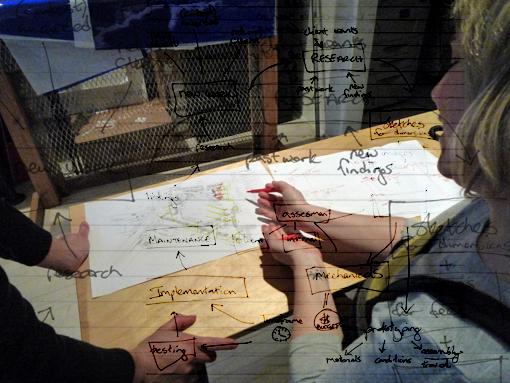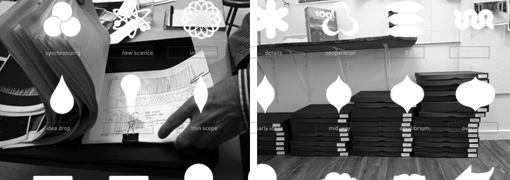Shedding Light on Design-Led Research
Posted on April 20, 2011 | posted by: In the beginning of our Research Seminar course, we were presented with the notion of Design-Led Research and Research-led design. One of our peers sketched a brilliant drawing of a circular road that went in perspective with research being the road, and an arc in the foreground standing for fieldwork and deign and the arc in the background arching over the research road which represented traditional institutions (science). Presented with the assignment to “reflect on our design practice and develop a research program that emerges from the work we intend to create”, the challenge was where to begin. I began by asking how a transdisciplinary designer might work meaningfully with other groups. However, as the definition and role of a transdiscipliary designer is so brand new —with its definition and clarity at a premature place—I struggled to establish a research question that held meaning and direction. After much iteration, with increased focus on the aspect I was really honing in on, my process of inquiry solidified into this two-part research question:
In the beginning of our Research Seminar course, we were presented with the notion of Design-Led Research and Research-led design. One of our peers sketched a brilliant drawing of a circular road that went in perspective with research being the road, and an arc in the foreground standing for fieldwork and deign and the arc in the background arching over the research road which represented traditional institutions (science). Presented with the assignment to “reflect on our design practice and develop a research program that emerges from the work we intend to create”, the challenge was where to begin. I began by asking how a transdisciplinary designer might work meaningfully with other groups. However, as the definition and role of a transdiscipliary designer is so brand new —with its definition and clarity at a premature place—I struggled to establish a research question that held meaning and direction. After much iteration, with increased focus on the aspect I was really honing in on, my process of inquiry solidified into this two-part research question:
How might design practice and process be understood as research methodology? And how might it illuminate points of intersection for new modes of communication between disciplines and organizations?
The research methodology I used included interviewing, transcript analysis and a photo audit. I found this methodology to lend itself to a naturalistic approach of inquiry, allowing for an on-going two-way dialogue between researcher and subjects.
Observations/Collection of Data: In order to focus on the process rather than the content of what was being researched, I chose to interview another type of design studio, a lighting design studio. I researched their projects, approached the principal and arranged to come visit their studio to interview and capture their process of both research and design. Not knowing what to expect, I promised to keep the interview to 30minutes. What occurred naturally was an inherent knowing of just listening to their responses with my ears, my eyes and every cell in my body. What resulted were a mutual engagement and an appreciation on both sides, as they found that talking about their process and discussing it was more valuable than they expected, and would be a process they would like to repeat in further depth. I recorded our dialogue and had taken a large number of images of their studio space to analyze.
Processing and Insights: Through inductive process I tried to establish patterns, reveal consistencies and find meaning. I began with the photographic images, over 80 of them, edited and grouped to represent the various stages of the lighting studio’s design/research process. Then I moved on to the interview. Naturalistic inquiry method was utilized for the interview—where the human component is central and participants are not overly prepared, but rather teasing out their tacit knowledge in how they work. Back at my studio, I transcribed the interview, organized and clustered the photos per their process and, extrapolated ideas, concepts to create the beginning of a visual etymology. I made an initial attempt at diagramming their process, but found it lacking in some essential qualities that we had discussed during the interview. One of the defining aspects I found missing in my original diagram was the dynamic concurrent cyclical nature of their design method.
Reflections and Assessment: As I work through my research process, one of my mini epiphanies, was just how important it is not to shoe-horn research into a cookie-cutter process, but to approach each situation with an adaptable approach to inquiry. My next step is to share this new methodology back with the lighting studio and begin the same process with two other organizations whose focus is on creating a certain type of space. In just a few brief visits I found that there are real insights to be had from an outside perspective and that disciplines from seemingly discreet backgrounds can find value through the shared language of process.
